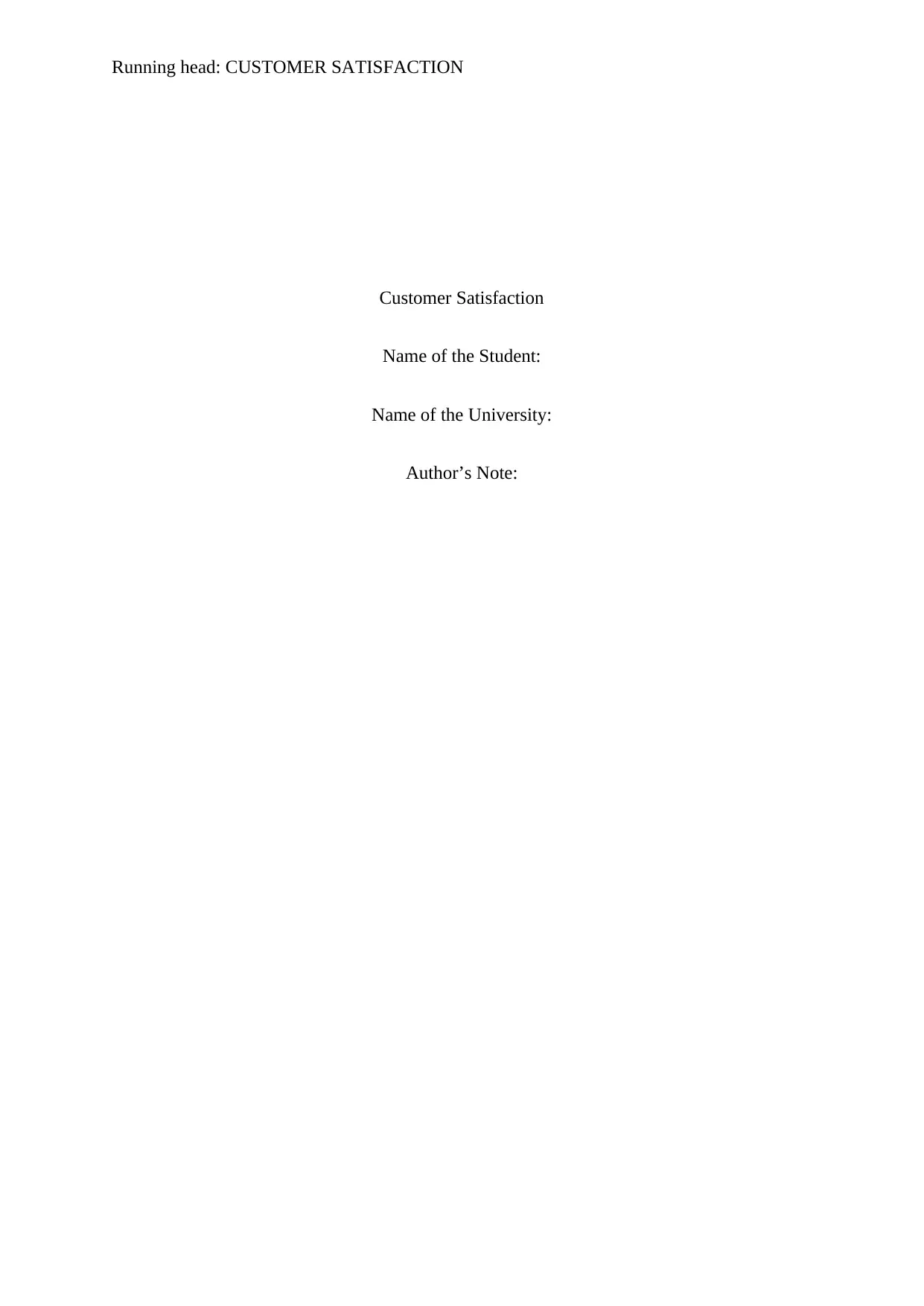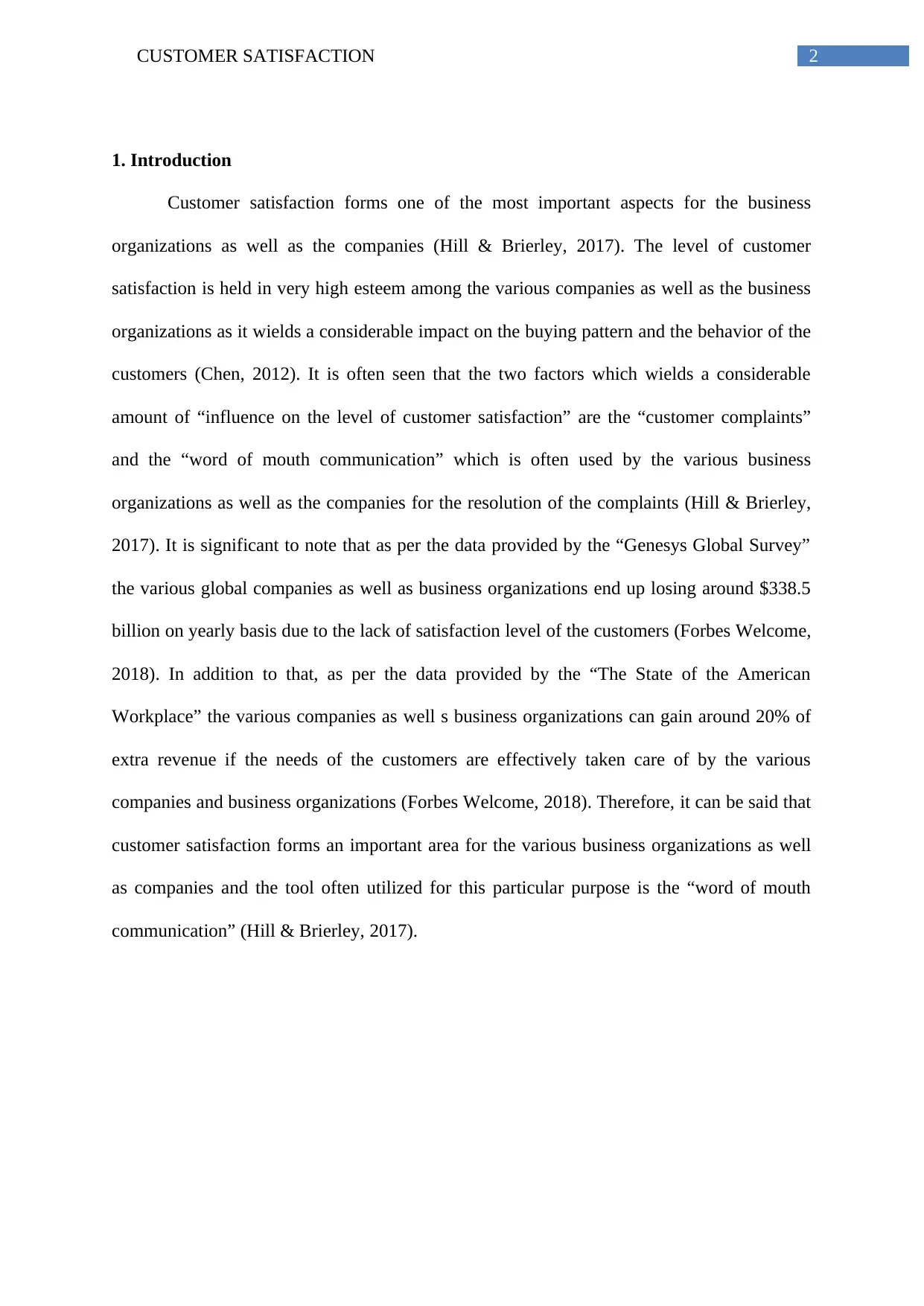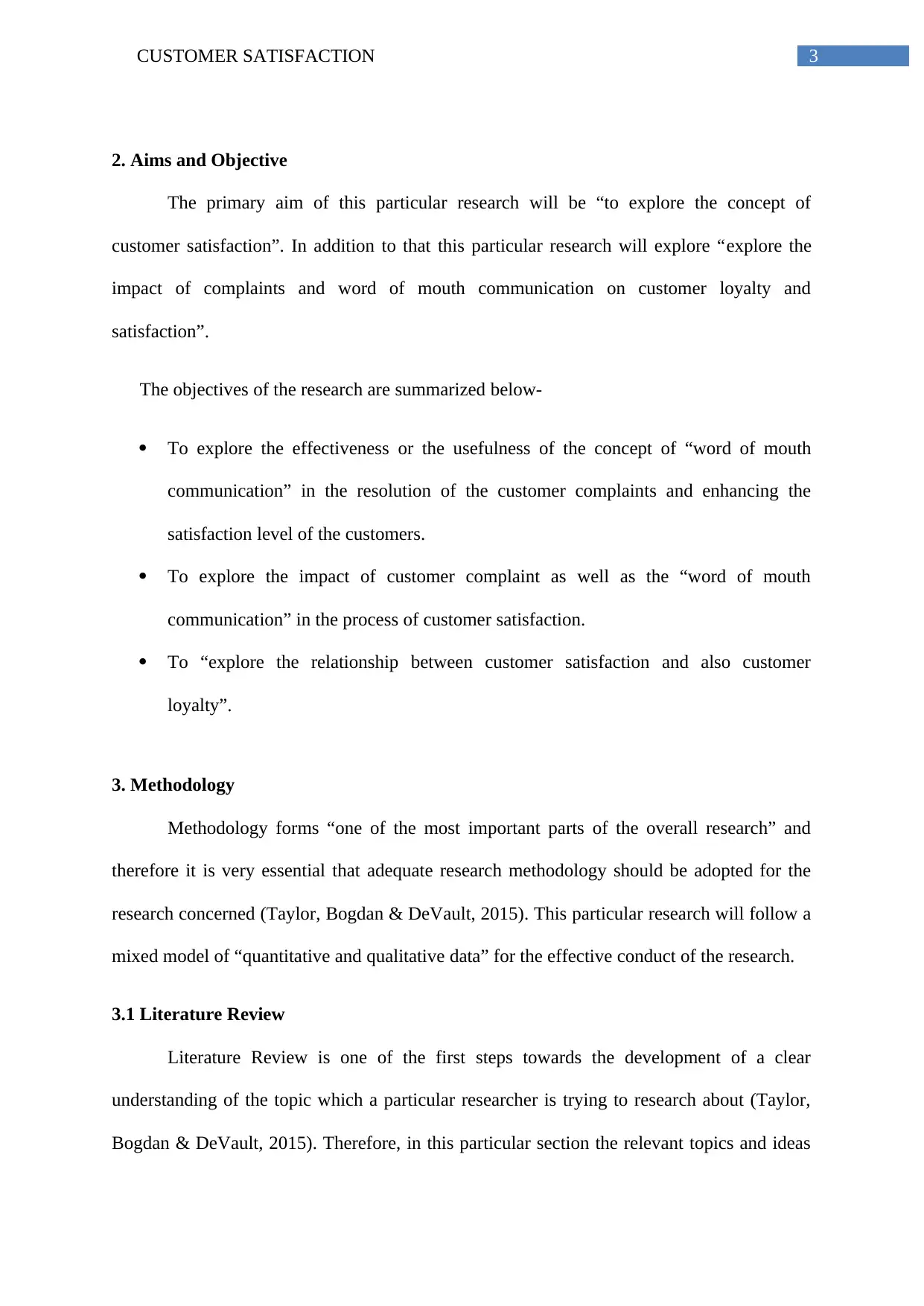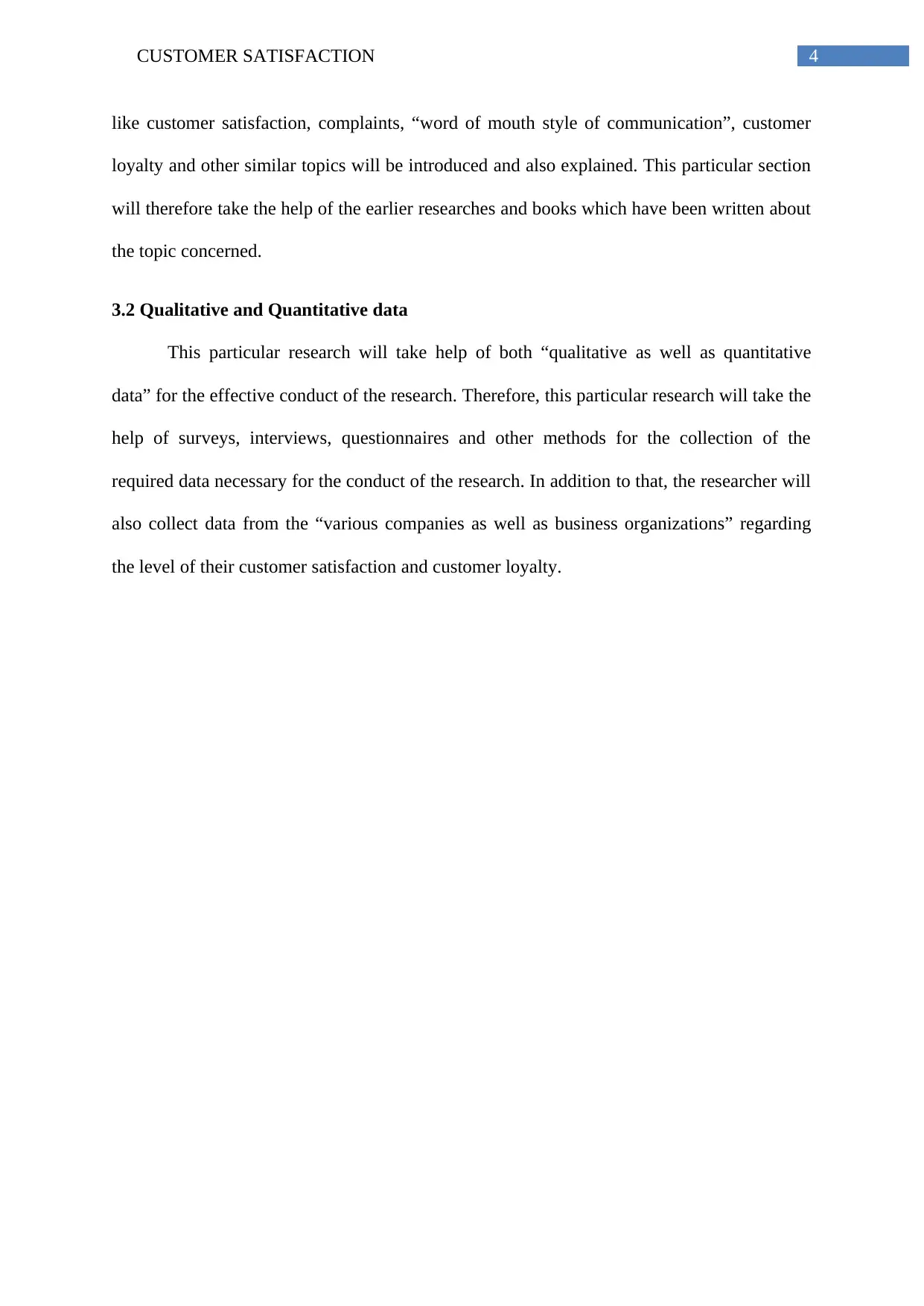BUSN20016: Complaints and Word of Mouth on Customer Satisfaction
VerifiedAdded on 2023/06/14
|6
|897
|107
Report
AI Summary
This report aims to explore the concept of customer satisfaction, focusing on the impact of complaints and word-of-mouth communication on customer loyalty. It outlines the significance of customer satisfaction for business organizations and highlights the financial implications of neglecting customer needs. The research objectives include assessing the effectiveness of word-of-mouth communication in resolving complaints, determining the impact of complaints and communication on satisfaction levels, and establishing the relationship between customer satisfaction and loyalty. The methodology involves a mixed-methods approach, incorporating both qualitative and quantitative data collection through literature review, surveys, interviews, and questionnaires, as well as data from companies regarding customer satisfaction and loyalty levels. The report references key studies and books related to customer satisfaction and communication strategies.

Running head: CUSTOMER SATISFACTION
Customer Satisfaction
Name of the Student:
Name of the University:
Author’s Note:
Customer Satisfaction
Name of the Student:
Name of the University:
Author’s Note:
Paraphrase This Document
Need a fresh take? Get an instant paraphrase of this document with our AI Paraphraser

1CUSTOMER SATISFACTION
Table of Contents
1. Introduction............................................................................................................................2
2. Aims and Objective................................................................................................................3
3. Methodology..........................................................................................................................3
3.1 Literature Review.............................................................................................................3
3.2 Qualitative and Quantitative data.....................................................................................4
References..................................................................................................................................5
Table of Contents
1. Introduction............................................................................................................................2
2. Aims and Objective................................................................................................................3
3. Methodology..........................................................................................................................3
3.1 Literature Review.............................................................................................................3
3.2 Qualitative and Quantitative data.....................................................................................4
References..................................................................................................................................5

2CUSTOMER SATISFACTION
1. Introduction
Customer satisfaction forms one of the most important aspects for the business
organizations as well as the companies (Hill & Brierley, 2017). The level of customer
satisfaction is held in very high esteem among the various companies as well as the business
organizations as it wields a considerable impact on the buying pattern and the behavior of the
customers (Chen, 2012). It is often seen that the two factors which wields a considerable
amount of “influence on the level of customer satisfaction” are the “customer complaints”
and the “word of mouth communication” which is often used by the various business
organizations as well as the companies for the resolution of the complaints (Hill & Brierley,
2017). It is significant to note that as per the data provided by the “Genesys Global Survey”
the various global companies as well as business organizations end up losing around $338.5
billion on yearly basis due to the lack of satisfaction level of the customers (Forbes Welcome,
2018). In addition to that, as per the data provided by the “The State of the American
Workplace” the various companies as well s business organizations can gain around 20% of
extra revenue if the needs of the customers are effectively taken care of by the various
companies and business organizations (Forbes Welcome, 2018). Therefore, it can be said that
customer satisfaction forms an important area for the various business organizations as well
as companies and the tool often utilized for this particular purpose is the “word of mouth
communication” (Hill & Brierley, 2017).
1. Introduction
Customer satisfaction forms one of the most important aspects for the business
organizations as well as the companies (Hill & Brierley, 2017). The level of customer
satisfaction is held in very high esteem among the various companies as well as the business
organizations as it wields a considerable impact on the buying pattern and the behavior of the
customers (Chen, 2012). It is often seen that the two factors which wields a considerable
amount of “influence on the level of customer satisfaction” are the “customer complaints”
and the “word of mouth communication” which is often used by the various business
organizations as well as the companies for the resolution of the complaints (Hill & Brierley,
2017). It is significant to note that as per the data provided by the “Genesys Global Survey”
the various global companies as well as business organizations end up losing around $338.5
billion on yearly basis due to the lack of satisfaction level of the customers (Forbes Welcome,
2018). In addition to that, as per the data provided by the “The State of the American
Workplace” the various companies as well s business organizations can gain around 20% of
extra revenue if the needs of the customers are effectively taken care of by the various
companies and business organizations (Forbes Welcome, 2018). Therefore, it can be said that
customer satisfaction forms an important area for the various business organizations as well
as companies and the tool often utilized for this particular purpose is the “word of mouth
communication” (Hill & Brierley, 2017).
⊘ This is a preview!⊘
Do you want full access?
Subscribe today to unlock all pages.

Trusted by 1+ million students worldwide

3CUSTOMER SATISFACTION
2. Aims and Objective
The primary aim of this particular research will be “to explore the concept of
customer satisfaction”. In addition to that this particular research will explore “explore the
impact of complaints and word of mouth communication on customer loyalty and
satisfaction”.
The objectives of the research are summarized below-
To explore the effectiveness or the usefulness of the concept of “word of mouth
communication” in the resolution of the customer complaints and enhancing the
satisfaction level of the customers.
To explore the impact of customer complaint as well as the “word of mouth
communication” in the process of customer satisfaction.
To “explore the relationship between customer satisfaction and also customer
loyalty”.
3. Methodology
Methodology forms “one of the most important parts of the overall research” and
therefore it is very essential that adequate research methodology should be adopted for the
research concerned (Taylor, Bogdan & DeVault, 2015). This particular research will follow a
mixed model of “quantitative and qualitative data” for the effective conduct of the research.
3.1 Literature Review
Literature Review is one of the first steps towards the development of a clear
understanding of the topic which a particular researcher is trying to research about (Taylor,
Bogdan & DeVault, 2015). Therefore, in this particular section the relevant topics and ideas
2. Aims and Objective
The primary aim of this particular research will be “to explore the concept of
customer satisfaction”. In addition to that this particular research will explore “explore the
impact of complaints and word of mouth communication on customer loyalty and
satisfaction”.
The objectives of the research are summarized below-
To explore the effectiveness or the usefulness of the concept of “word of mouth
communication” in the resolution of the customer complaints and enhancing the
satisfaction level of the customers.
To explore the impact of customer complaint as well as the “word of mouth
communication” in the process of customer satisfaction.
To “explore the relationship between customer satisfaction and also customer
loyalty”.
3. Methodology
Methodology forms “one of the most important parts of the overall research” and
therefore it is very essential that adequate research methodology should be adopted for the
research concerned (Taylor, Bogdan & DeVault, 2015). This particular research will follow a
mixed model of “quantitative and qualitative data” for the effective conduct of the research.
3.1 Literature Review
Literature Review is one of the first steps towards the development of a clear
understanding of the topic which a particular researcher is trying to research about (Taylor,
Bogdan & DeVault, 2015). Therefore, in this particular section the relevant topics and ideas
Paraphrase This Document
Need a fresh take? Get an instant paraphrase of this document with our AI Paraphraser

4CUSTOMER SATISFACTION
like customer satisfaction, complaints, “word of mouth style of communication”, customer
loyalty and other similar topics will be introduced and also explained. This particular section
will therefore take the help of the earlier researches and books which have been written about
the topic concerned.
3.2 Qualitative and Quantitative data
This particular research will take help of both “qualitative as well as quantitative
data” for the effective conduct of the research. Therefore, this particular research will take the
help of surveys, interviews, questionnaires and other methods for the collection of the
required data necessary for the conduct of the research. In addition to that, the researcher will
also collect data from the “various companies as well as business organizations” regarding
the level of their customer satisfaction and customer loyalty.
like customer satisfaction, complaints, “word of mouth style of communication”, customer
loyalty and other similar topics will be introduced and also explained. This particular section
will therefore take the help of the earlier researches and books which have been written about
the topic concerned.
3.2 Qualitative and Quantitative data
This particular research will take help of both “qualitative as well as quantitative
data” for the effective conduct of the research. Therefore, this particular research will take the
help of surveys, interviews, questionnaires and other methods for the collection of the
required data necessary for the conduct of the research. In addition to that, the researcher will
also collect data from the “various companies as well as business organizations” regarding
the level of their customer satisfaction and customer loyalty.

5CUSTOMER SATISFACTION
References
Chen, S. C. (2012). The customer satisfaction–loyalty relation in an interactive e-service
setting: The mediators. Journal of Retailing and Consumer Services, 19(2), 202-210.
Forbes Welcome. (2018). Forbes.com. Retrieved 3 April 2018, from
https://www.forbes.com/sites/ciocentral/2012/04/19/customer-satisfaction-by-the-
numbers-an-industry-breakdown/#28c89712580f
Forbes Welcome. (2018). Forbes.com. Retrieved 3 April 2018, from
https://www.forbes.com/sites/shephyken/2017/05/27/how-happy-employees-make-
happy-customers/#41089c835c35
Hill, N., & Brierley, J. (2017). How to measure customer satisfaction. Routledge.
Taylor, S. J., Bogdan, R., & DeVault, M. (2015). Introduction to qualitative research
methods: A guidebook and resource. John Wiley & Sons.
References
Chen, S. C. (2012). The customer satisfaction–loyalty relation in an interactive e-service
setting: The mediators. Journal of Retailing and Consumer Services, 19(2), 202-210.
Forbes Welcome. (2018). Forbes.com. Retrieved 3 April 2018, from
https://www.forbes.com/sites/ciocentral/2012/04/19/customer-satisfaction-by-the-
numbers-an-industry-breakdown/#28c89712580f
Forbes Welcome. (2018). Forbes.com. Retrieved 3 April 2018, from
https://www.forbes.com/sites/shephyken/2017/05/27/how-happy-employees-make-
happy-customers/#41089c835c35
Hill, N., & Brierley, J. (2017). How to measure customer satisfaction. Routledge.
Taylor, S. J., Bogdan, R., & DeVault, M. (2015). Introduction to qualitative research
methods: A guidebook and resource. John Wiley & Sons.
⊘ This is a preview!⊘
Do you want full access?
Subscribe today to unlock all pages.

Trusted by 1+ million students worldwide
1 out of 6
Related Documents
Your All-in-One AI-Powered Toolkit for Academic Success.
+13062052269
info@desklib.com
Available 24*7 on WhatsApp / Email
![[object Object]](/_next/static/media/star-bottom.7253800d.svg)
Unlock your academic potential
Copyright © 2020–2025 A2Z Services. All Rights Reserved. Developed and managed by ZUCOL.




